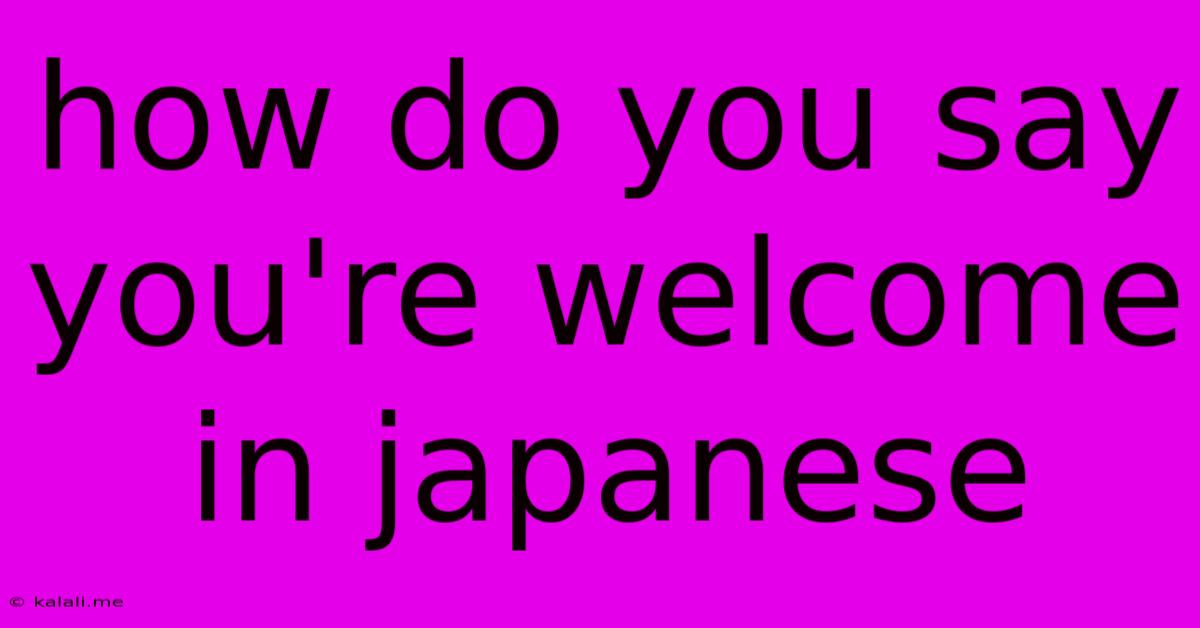How Do You Say You're Welcome In Japanese
Kalali
Jun 07, 2025 · 3 min read

Table of Contents
How Do You Say "You're Welcome" in Japanese? A Guide to Polite Responses
So, you've helped someone out, and they've thanked you with a polite "arigato" (ありがとう). Now, how do you respond gracefully in Japanese? Simply saying "you're welcome" isn't a direct translation; the Japanese approach emphasizes humility and context. This guide will explore several ways to say "you're welcome" in Japanese, helping you navigate different social situations with confidence. Understanding the nuances will elevate your Japanese communication skills.
There's no single perfect equivalent to "you're welcome" in Japanese, as the appropriate response depends on the situation and your relationship with the person you're speaking to. However, several common phrases convey similar sentiments of politeness and gratitude.
Common Ways to Say "You're Welcome" in Japanese
-
どういたしまして (dō itashimashite): This is the most common and versatile response to "arigato" (ありがとう). It literally translates to "that's nothing" or "it was nothing at all," but it's the closest equivalent to "you're welcome" in most situations. It's polite and suitable for almost any context, making it a safe and reliable choice. This phrase is perfectly acceptable for formal and informal settings alike.
-
いいえ (iie): This simply means "no," but in the context of a thank you, it functions similarly to "you're welcome." It conveys a sense of humility, suggesting that the act wasn't a significant effort. It’s less formal than dō itashimashite and is better suited for casual conversations with friends and family.
-
全然大丈夫ですよ (zenzen daijōbu desu yo): This translates to "it's perfectly alright" or "not at all," expressing that the favor was no trouble. This phrase is a bit more emphatic than iie and dō itashimashite, implying that the task was easily handled. Use this phrase in informal settings.
-
気にしないでください (ki ni shinaide kudasai): This phrase means "please don't mind it" or "don't worry about it." This is a suitable response when someone is excessively apologetic or thanking you profusely for a small favor. It suggests that the act was inconsequential.
Choosing the Right Response: Context Matters
The best way to say "you're welcome" in Japanese depends largely on the context of the interaction. Consider these factors:
-
Formality: Dō itashimashite is always a safe bet for formal situations, while iie is better suited for informal settings.
-
The Nature of the Favor: For a significant favor, a more emphatic response like zenzen daijōbu desu yo might be appropriate. For a small act of kindness, iie or dō itashimashite would suffice.
-
Your Relationship with the Person: Use more casual phrases like iie or zenzen daijōbu desu yo with close friends and family, reserving dō itashimashite for more formal relationships or unfamiliar individuals.
By understanding these nuances, you can respond to "arigato" with grace and politeness, further strengthening your relationships in Japanese culture. Remember, practice makes perfect, so don't hesitate to use these phrases in real-life conversations. Over time, you’ll naturally develop a feel for which response is most appropriate in each situation.
Latest Posts
Latest Posts
-
Object Of Type Bytes Is Not Json Serializable
Jun 07, 2025
-
Angle Cut For Back Of Wooden Bench
Jun 07, 2025
-
How To Fix A Dry Flavorless Cake
Jun 07, 2025
-
Improper Configure As Number On A Device
Jun 07, 2025
-
Put Mixed Ground Beef For Burgers Back In Fridge
Jun 07, 2025
Related Post
Thank you for visiting our website which covers about How Do You Say You're Welcome In Japanese . We hope the information provided has been useful to you. Feel free to contact us if you have any questions or need further assistance. See you next time and don't miss to bookmark.